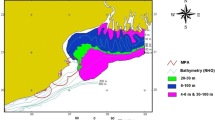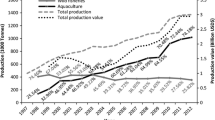Abstract
Reducing fishing effort and fishing capacity was labelled by the Food and Agriculture Organisation (FAO) as a key requirement to ensure the sustainability of global fisheries. The objective of this paper was to analyse the evolution of fishing effort and capacity during the last two decades in Egypt’s marine fisheries. Fishing effort (number of licences and fishers), capacity (number of vessels and engine power) and landings data were obtained from the fisheries management agency’ annual statistical books (2000–2019). The evolution of fishing effort and capacity in total, for Mediterranean and Red Sea fisheries, also by gear and port was presented. The annual catch per unit effort (CPUE), maximum sustainable yield (MSY) and fleet overcapacity were calculated. Some of these indicators were compared to Saudi fisheries in the Red Sea to provide regional insight into the northern Red Sea. Results highlighted the overcapacity of the Egyptian Mediterranean fleet in terms of engine power (increasing average hp) while the Red Sea in terms of number of vessels. The estimated MSY was about 64,388 tonnes for the Mediterranean Sea and about 66,823 tonnes for the Red Sea. The number of vessels was higher about 1.68% and 36.67% than the estimated optimum number of vessels for the Mediterranean and Red Sea respectively. Both fleets’ CPUE is now less than it was in the beginning of this century despite considerable technological advancement. Limitations, gaps and future direction to address the issue of overcapacity and the management of these fisheries are provided in the last section.





Similar content being viewed by others
Data availability
The data used in the paper are extracted from statistical books issued by the governmental agency (GAFRD). It is owned and already published by the government. The authors have no right to provide the data for the third parties.
References
Anticamara JA, Watson R, Gelchu A, Pauly D (2011) Global fishing effort (1950–2010): trends, gaps, and implications. Fish Res 107(1–3):131–136. https://doi.org/10.1016/j.fishres.2010.10.016
Bell JD, Watson RA, Ye Y (2017) Global fishing capacity and fishing effort from 1950 to 2012. Fish Fish 18(3):489–505. https://doi.org/10.1111/faf.12187
Cardinale M, ChatoOsio G, Scarcella G (2017) Mediterranean Sea. A failure of the European fisheries management system. Front Mar Sci 4:72. https://doi.org/10.3389/fmars.2017.00072
Colloca F, Scarcella G, Libralato S (2017) Recent trends and impacts of fisheries exploitation on Mediterranean stocks and ecosystems. Front Mar Sci 4:244. https://doi.org/10.3389/fmars.2017.00244
Eigaard OR, Marchal P, Gislason H, Rijnsdorp AD (2014) Technological development and fisheries management. Rev Fish Sci Aquac 22(2):156–174. https://doi.org/10.1080/23308249.2014.899557
FAO (2014) The state of world fisheries and aquaculture. Food and agriculture organization of the united nations, Rome. 223 pp. https://www.fao.org/3/i3720e/i3720e.pdf. Accessed Dec 2022
FAO (2018) The State of world fisheries and aquaculture 2018 - meeting the sustainable development goals. Rome. 227 pp. Licence: CC BY-NC-SA 3.0 IGO. https://www.fao.org/3/i9540en/i9540en.pdf. Accessed Dec 2022
Gillis DM, Peterman RM (1998) Implications of interference among fishing vessels and the ideal free distribution to the interpretation of CPUE. Can J Fish Aquat Sci 55(1):37–46. https://doi.org/10.1139/f97-206
Hilborn R, Branch TA, Ernst B, Magnusson A, Minte-Vera CV et al (2003) State of the world’s fisheries. Annu Rev Env Resour 28(1):359–399. https://doi.org/10.1146/annurev.energy.28.050302.105509
Maiyza S, Mehanna S, El-karyoney I (2020) An evaluation for the exploitation level of Egyptian Marine Fisheries. Egyptian J Aquat Biol Fish 24:441–452. https://doi.org/10.21608/ejabf.2020.121292
Maynou F (2020) Evolution of fishing capacity in a Mediterranean fishery in the first two decades of the 21st c. Ocean Coast Manage 192:105190. https://doi.org/10.1016/j.ocecoaman.2020.105190
Mehanna S, Eid MS, Ali AH, Aabed SM (2020) Fishing gears, catch composition and length at first capture of the common fish species in Bardawil lagoon, Egypt. Egyptian J Aquat Biol Fish 24(5):523–538. https://doi.org/10.21608/EJABF.2020.108593
Mehanna SF (2022) Egyptian marine fisheries and its sustainability. In Sustainable fish production and processing. Academic Press, pp 111–140. https://doi.org/10.1016/B978-0-12-824296-4.00010-4
Murray LG, Hinz H, Hold N, Kaiser MJ (2013) The effectiveness of using CPUE data derived from Vessel Monitoring Systems and fisheries logbooks to estimate scallop biomass. ICES J Mar Sci 70(7):1330–1340. https://doi.org/10.1093/icesjms/fst099
Osman YA, Samy-Kamal M (2023) Diversity and characteristics of commercial Red Sea fish species based on fish market survey: informing management to reduce the risk of overfishing. J Fish Biol 102(4):936–951. https://doi.org/10.1111/jfb.15339
Pauly D, Christensen V, Guénette S, Pitcher TJ, Sumaila UR et al (2002) Towards sustainability in world fisheries. Nature 418(6898):689–695. https://doi.org/10.1038/nature01017
Rousseau Y, Watson RA, Blanchard JL, Fulton EA (2019) Evolution of global marine fishing fleets and the response of fished resources. Proc Nat Acad Sci 116(25):12238–12243. https://doi.org/10.1073/pnas.1820344116
Samy-Kamal M (2015) Status of fisheries in Egypt: reflections on past trends and management challenges. Rev Fish Biol Fisher 25(4):631–649. https://doi.org/10.1007/s11160-015-9404-z
Samy-Kamal M (2020) Outlook on the fisheries policy reform in Egypt and the draft of the new fisheries law. Mar Policy 120:104136. https://doi.org/10.1016/j.marpol.2020.104136
Samy-Kamal M (2021) Prices in the Egyptian seafood market: insights for fisheries management and food security. Fish Res 233:105764. https://doi.org/10.1016/j.fishres.2020.105764
Samy-Kamal M (2022) Insights on illegal, unreported and unregulated (IUU) fishing activities by Egyptian vessels in neighbouring countries. Fishes 7(5):288. https://doi.org/10.3390/fishes7050288
Samy-Kamal M, Teixeira CM (2023) Diagnosis and management of small-scale and data-limited fisheries. Fishes 8(1):39. https://doi.org/10.3390/fishes8010039
Samy-Kamal M, Forcada A, Sánchez-Lizaso JL (2014) Trawling fishery of the western Mediterranean Sea: Métiers identification, effort characteristics, landings and income profiles. Ocean Coast Manage 102:269–284. https://doi.org/10.1016/j.ocecoaman.2014.10.005
Samy-Kamal M, Forcada A, Sánchez-Lizaso JL (2015a) Effects of seasonal closures in a multi-specific fishery. Fish Res 172:303–317. https://doi.org/10.1016/j.fishres.2015.07.027
Samy-Kamal M, Forcada A, Sánchez-Lizaso JL (2015b) Daily variation of fishing effort and ex-vessel prices in a western Mediterranean multi-species fishery: implications for sustainable management. Mar Policy 61:187–195. https://doi.org/10.1016/j.marpol.2015.08.015
Schaefer MB (1954) Some aspects of the dynamic of population important to the management of the commercial marine fisheries. Bull Inter-American Trop Tuna Comm 1(2):27–56. http://hdl.handle.net/1834/21257. Accessed Dec 2022
Tsikliras AC, Dinouli A, Tsiros VZ, Tsalkou E (2015) The Mediterranean and Black Sea fisheries at risk from overexploitation. PloS one 10(3):e0121188. https://doi.org/10.1371/journal.pone.0121188
Vasilakopoulos P, Maravelias CD, Tserpes G (2014) The alarming decline of Mediterranean fish stocks. Curr Biol 24:1643–1648. https://doi.org/10.1016/j.cub.2014.05.070
Watson RA, Cheung WW, Anticamara JA, Sumaila RU, Zeller D et al (2013) Global marine yield halved as fishing intensity redoubles. Fish Fish 14(4):493–503. https://doi.org/10.1111/j.1467-2979.2012.00483.x
Worm B, Hilborn R, Baum JK, Branch TA, Collie JS et al (2009) Rebuilding global fisheries. Science 325(5940):578–585. https://doi.org/10.1126/science.1173146
Author information
Authors and Affiliations
Corresponding author
Additional information
Communicated by Wolfgang Cramer
Publisher's note
Springer Nature remains neutral with regard to jurisdictional claims in published maps and institutional affiliations.
Supplementary Information
Below is the link to the electronic supplementary material.
Rights and permissions
Springer Nature or its licensor (e.g. a society or other partner) holds exclusive rights to this article under a publishing agreement with the author(s) or other rightsholder(s); author self-archiving of the accepted manuscript version of this article is solely governed by the terms of such publishing agreement and applicable law.
About this article
Cite this article
Samy-Kamal, M., Mehanna, S.F. Evolution of fishing effort and fishing capacity during the last two decades (2000–2019) in Egypt’s marine fisheries: spotting the fleet overcapacity. Reg Environ Change 23, 113 (2023). https://doi.org/10.1007/s10113-023-02107-1
Received:
Accepted:
Published:
DOI: https://doi.org/10.1007/s10113-023-02107-1




